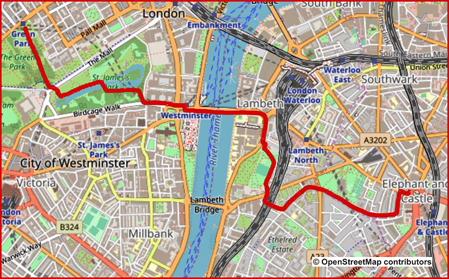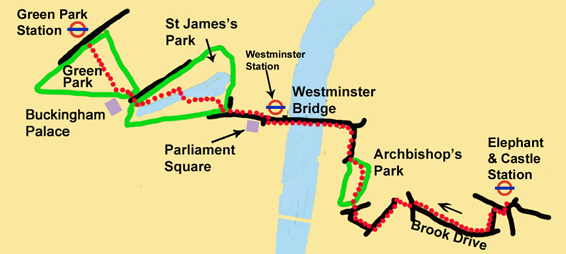Walk 22 - From Elephant & Castle, at the Southern End of the Bakerloo Line, to Green Park Tube Station

|
Distance8 |
6 km (4 miles) |
|
Underfoot |
Paved throughout |
|
Outward Journey |
Bakerloo Line to Elephant & Castle About 10 minutes from Central London |
|
Return |
By Piccadilly or Jubilee Line from Green Park |
|
Points of Interest |
Imperial War Museum, Archbishops Park, Westminster Bridge, the London Eye, Houses of Parliament, St James's Park, Buckingham Palace |
|
Refreshments |
Tankard Pub in Brooke Drive, cafe in St James's Park, cafes in Piccadilly |
|
Public Toilets |
Archbishop's Park |
|
Shortening the Walk |
Finish at Westminster Underground Station. Several bus stops en route. |

What To Expect From This Walk

The walk starts from Elephant & Castle Underground Station and takes in many visitor attractions. From the Bakerloo Line exit at Elephant & Castle, you go down side streets to Archbishop's Park, one of the less well-known green spaces in Central London. You leave the park opposite St Thomas’ Hospital and soon cross Westminster Bridge, with the London Eye on your right and the Houses of Parliament ahead. After crossing Parliament Square, you come to St James's Park with its lake and wildfowl, including the famous pelicans. On the final section you pass close to Buckingham Palace before crossing Green Park to reach Piccadilly. The walk finishes at Green Park Underground Station.
Route Directions

1. Leave Elephant & Castle Station via the exit from the Bakerloo Line and cross at the traffic lights directly in front of you to reach the other side of St George’s Road (the A302). Turn right along the foot-way and then take the first road left (Oswin Street). Walk to a junction and turn right into Brook Drive. Continue for 500m to the junction with Kennington Road. The Imperial War Museum is on your right and The Tankard pub on your left.
2. Cross Kennington Road at the lights. Go ahead through a gap between two blocks of flats and walk through a small parking area to reach a corner where a road comes in from the right and turns to go ahead. Your route is straight ahead on this road. Continue for about 400m, then turn right into Juxon Street, which brings you out onto Lambeth Road. Cross the road and go ahead into Archbishop’s Park.
3. You can walk left or right around the perimeter of the park. Your exit is at the far left-hand corner. If you choose the right-hand path you will pass the public toilets. As you leave the park you will see St Thomas’ Hospital over on the opposite side of the road. Cross the road, turn right and follow the footway to go left onto Westminster Bridge Road. You will see the Houses of Parliament ahead. When you reach the bridge, you will also see the London Eye to your right.

4. Cross over Westminster Bridge, past Westminster Underground Station, and continue in the same direction. The Houses of Parliament are to your left. Cross over to the right-hand footway and resume your direction by crossing at the lights at the lower end of Whitehall. Pass Parliament Square on your left. Go ahead into Great George Street, which leads to Birdcage Walk. St James’s Park is now on your right. Take the first entrance to the park. Walk down to the lake and turn left. Continue with the lake on your right until you reach a bridge.
5. Cross the bridge and turn left to continue with the lake now on your left. Just before you reach the end of the lake, turn right up a path. Leave St James’s Park and cross The Mall, with Buckingham Palace on your left. Enter Green Park and swing left around a curving wall. Turn right at the first major crossing path to walk uphill for about 450m to reach Green Park Station.
Information on Things You Will See
The London Eye on the Southbank is the world’s largest observation wheel and the most popular paid tourist attraction in the UK. Developed and constructed in Norway to mark the Millennium, the London Eye is the only cantilevered structure of its kind. The wheel was transported along the river on barges and lifted to its final position on 10 October 1999, but only after a failed attempt the day before. The 32 capsules of the Eye are symbolic of London’s 32 boroughs and are numbered 1 to 33 (eliminating the number thirteen!).
The Pelicans of St James’s Park were introduced to the park in 1664 as a gift from the Russian Ambassador. These large birds now form a colony which includes several Eastern Whites and at least one South American White. They are fed by park rangers between 14.30 and 15.00 daily. They are extremely sociable animals and have been known to leave the lake and sit on the benches beside office workers and tourists.
Buckingham Palace has served as the official London residence of British monarchs since 1837. Built by the Duke of Buckingham in 1703 as Buckingham House, it was purchased by George III in 1761 as a family home for his wife Queen Charlotte. The Palace consists of 775 rooms, including 19 State rooms, 52 royal and guest bedrooms, 188 staff bedrooms and 78 bathrooms. It is the administrative headquarters of the monarch and the Royal Standard is flown when the king or queen is present.
Big Ben is the nickname for the great bell of the clock at the north end of the Palace of Westminster. The tower is now officially known as the Elizabeth Tower having been renamed in honour of the Queen’s Diamond Jubilee Despite being one of the world's most famous tourist attractions, the interior of the tower is not open to visitors, though UK residents are able to arrange tours, well in advance, through their Member of Parliament. However, the tower has no lift. So, those escorted, must climb the 334 limestone stairs to the top.Due to changes in ground conditions since construction, the tower leans slightly to the north-west, by roughly 230 millimetres (9.1 in) over 55 m height, giving an inclination of approximately 1/240. Due to thermal effects it oscillates annually by a few millimetres east and west.


